
Cornus controversa - pagoda dogwood and Cornus alternifolia: planting and maintenance
Contents
The Pagoda Dogwood in a nutshell
- The Cornus controversa or Pagoda Dogwood is a tree with a tabular, tiered habit
- The Cornus alternifolia closely resembles it, but remains smaller, almost a bush
- The flowering is in spring, and the deciduous foliage takes on beautiful hues in autumn
- These two dogwoods require a spot in partial shade or sun in moist soil
- The soil should be rich, humus-bearing, moist, but well-drained
The word from our expert
If there’s one tree among the dogwoods that never goes unnoticed in the garden or parks, it’s the Cornus controversa or Pagoda Dogwood. Indeed, the foliage is interesting all year round, especially if it’s variegated, as in the case of Cornus controversa ‘Variegata’, and it takes on beautiful colours in autumn. The spring flowering, with its clusters of numerous small cream flowers, attracts attention as much as insects. The blue-black fruits are highly decorative until the birds discover them and feast on them. The reddish young shoots are stunning in winter. But above all, the tree’s silhouette, with its tiered, tabular habit, is simply remarkable in every season.
“But what is the Cornus alternifolia doing in this plant profile?” you might ask. We chose to write a shared profile for these two dogwoods because the Cornus alternifolia or Alternate-leaf Dogwood, the American counterpart, closely resembles its “big brother” from Asia, but… in a smaller size. It has all the qualities mentioned above (though with darker young shoots) and is perfect for gardens of modest size.
These two magnificent species of dogwoods, available in several cultivars, thrive in rich, moist, but well-drained soil. A partially shaded spot suits them perfectly, though you can try planting Cornus controversa in full sun in more humid climates.
The Pagoda Dogwood and the Alternate-leaf Dogwood can be planted as standalone specimens, at the centre of a shrub bed, or even in rows. The key is to give them all the space they need to develop in both width and height. And most importantly, ensure they remain the focal points of your garden. In short: these are dogwoods to show off to all your garden visitors. Don’t hide them!
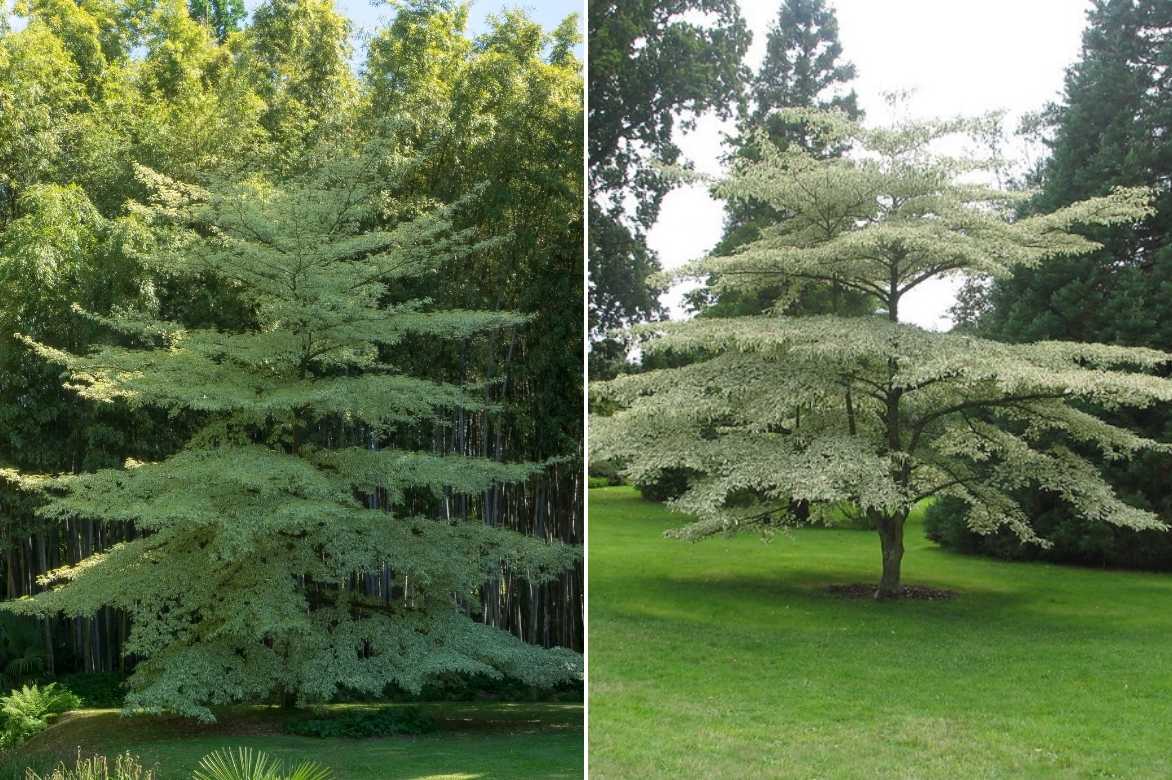
Cornus controversa ‘Variegata’ on the left, and Cornus alternifolia ‘Argentea’ on the right (© Peganum)
Botany and description
Botanical data
- Latin name Cornus controversa
- Family Cornaceae
- Common name Pagoda Dogwood, Giant Dogwood
- Flowering May to June
- Height between 10 and 20 m
- Exposure sun or partial shade
- Soil type clay-loam, remaining moist
- Hardiness -15°C
The Cornus controversa and Cornus alternifolia are two species of dogwoods with a tabular habit. Both belong to the subgenus Swida, like the well-known dogwoods with coloured stems: Cornus alba, Cornus sanguinea, and Cornus sericea. These are dogwoods whose flowers lack an involucre of bracts. In older botany books, you may still find the names Swida controversa and Swida alternifolia.
Cornus controversa
The Cornus controversa or Pagoda Dogwood (also known as Giant Dogwood) is a tree from the Cornaceae family. Its natural range extends from Japan to China, including Korea, India, Nepal, Bhutan, and Taiwan. The natural habitat of Cornus controversa is mixed forests of deciduous and coniferous trees.
Its habit is quite characteristic: tabular, meaning tiered. Its branches grow almost horizontally, which earned it the common name of Pagoda Tree or Pagoda Dogwood. It is a tree with smooth bark that spreads over the years, developing a broad, pyramidal shape. The bark turns greyish with age, but the young shoots are bright red.
Its foliage is deciduous and, surprisingly for a dogwood, alternate. Only this species and Cornus alternifolia have alternate leaves; other species in the genus (C. alba, C. sanguinea, C. sericea, C. florida, C. kousa…) have opposite leaves. The Cornus alternifolia, though smaller, is botanically similar to Cornus controversa, and both are cultivated in the same way. Each leaf is traversed by 5 to 9 longitudinal veins. The leaves are ovate with a pointed tip and an angular base. The foliage is a beautiful glossy green on top and light grey-blue on the underside. The foliage turns fiery shades in autumn. In some cultivars, the foliage is variegated, as in the now-famous Cornus controversa ‘Variegata’.
Flowering occurs in spring, from May to June. The inflorescences are broad, flat corymbs of numerous tiny cream-white, star-shaped flowers with four petals. The fruits are small spherical blue-black drupes containing a small stone.
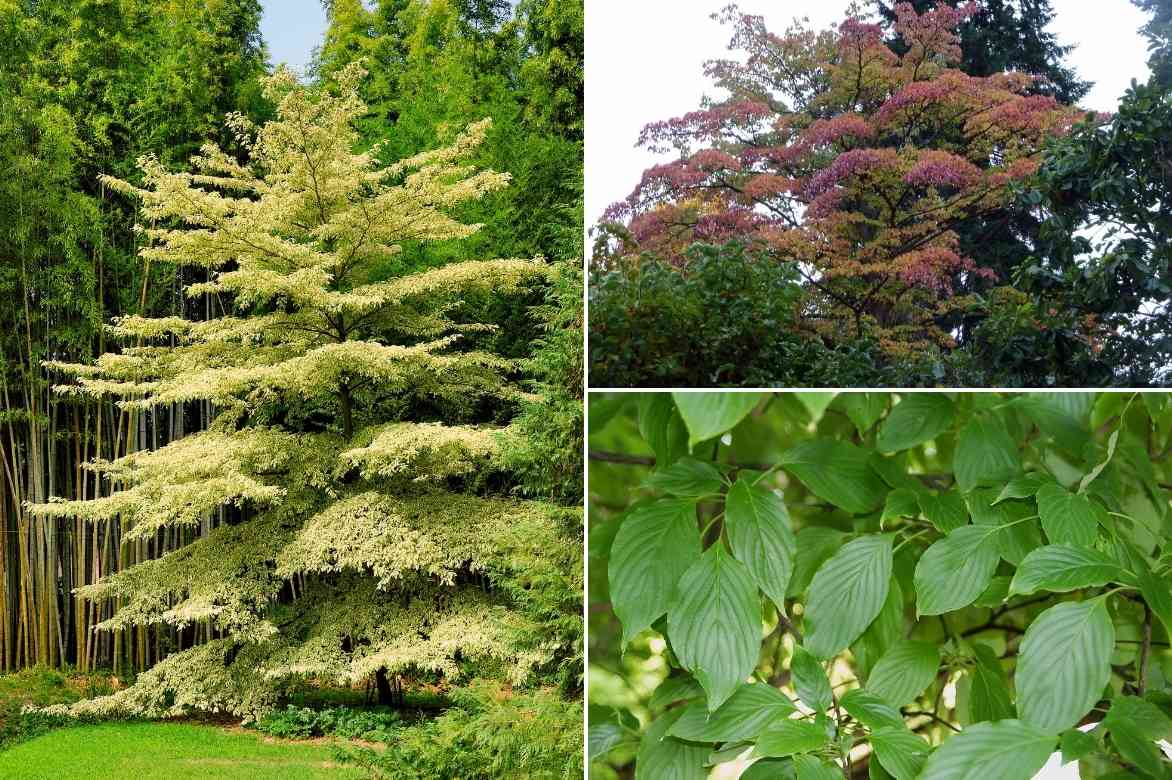
The absolute elegance of Cornus controversa ‘Variegata’, the colourful autumn foliage (©Wendy Cutler), and the foliage of the species type
Cornus alternifolia
The Cornus alternifolia or Alternate-leaf Dogwood, native to the northeastern part of North America, is more of a large bush and differs from Cornus controversa in a few ways: the young shoots are red-purple, sometimes almost black. The foliage is less rounded and more tapered than that of the Pagoda Dogwood. Additionally, it turns a very beautiful shade in autumn, transitioning from yellow, contrasting admirably with the dark shoots, to a matte violet-bordeaux later on.
The flowering, similar to that of Cornus controversa, occurs in late May or early June, after the foliage appears. The inflorescences, corymbs, are flat, composed of numerous small cream-white flowers, and positioned above the foliage. The fruit is a small blue-black drupe appreciated by birds.
The size of the Alternate-leaf Dogwood is also more compact, making it ideal for small gardens: about 5 m in all directions at maturity for the species type, and much less for the varieties. There are also beautifully coloured varieties, such as ‘Golden Shadows’ with leaves variegated in golden yellow or ‘Pinky Spots’ with tricolour foliage: green, white, and pink.

On the left, silhouette of Cornus alternifolia ‘Argentea’ (© Peganum), on the right, foliage of the Cornus alternifolia type
Our favourite varieties

Cornus controversa - Giant Dogwood
- Flowering time July, August
- Height at maturity 12 m
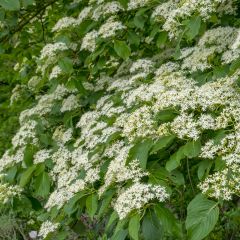
Cornus controversa Pagoda - Giant Dogwood
- Flowering time June, July
- Height at maturity 12 m
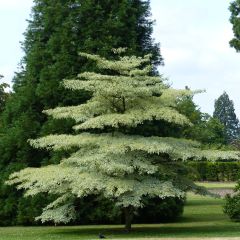
Cornus controversa Variegata - Giant Dogwood
- Flowering time July, August
- Height at maturity 7 m

Cornus alternifolia - Pagoda Dogwood
- Flowering time June, July
- Height at maturity 5 m

Cornus alternifolia Golden Shadows - Pagoda Dogwood
- Flowering time June, July
- Height at maturity 3 m
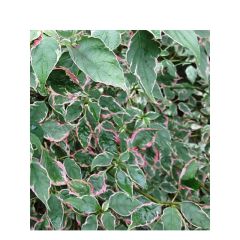
Cornus alternifolia Pinky Spot Minpinky - Pagoda Dogwood
- Flowering time August, September
- Height at maturity 3,50 m
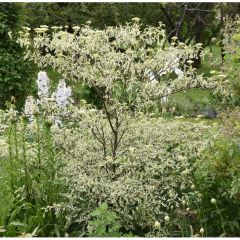
Cornus alternifolia Argentea - Pagoda Dogwood
- Flowering time June, July
- Height at maturity 3 m
Discover other Cornus
View all →Available in 0 sizes
Available in 0 sizes
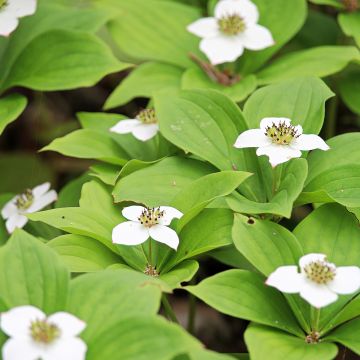
Available in 2 sizes
Available in 1 sizes
Available in 2 sizes
Available in 2 sizes
Available in 1 sizes
Available in 3 sizes
Available in 2 sizes
Available in 3 sizes
How to plant a Cornus controversa?
Where to Plant?
The Cornus controversa and Cornus alternifolia are relatively undemanding when it comes to soil. The soil should be rich, non-calcareous, and not too heavy. The ground should remain moist throughout the year, as if it is too dry, the tree will struggle. It can tolerate clay soils, but the soil must always be well-drained.
In terms of exposure, these dogwoods thrive best in partial shade, in a woodland-like setting. However, the Cornus controversa can grow in full sun if it is not too scorching.
When to Plant?
You can plant it from March to April or, even better, in autumn: from October to November. Autumn planting will allow your dogwood to develop a strong root system for the coming year.
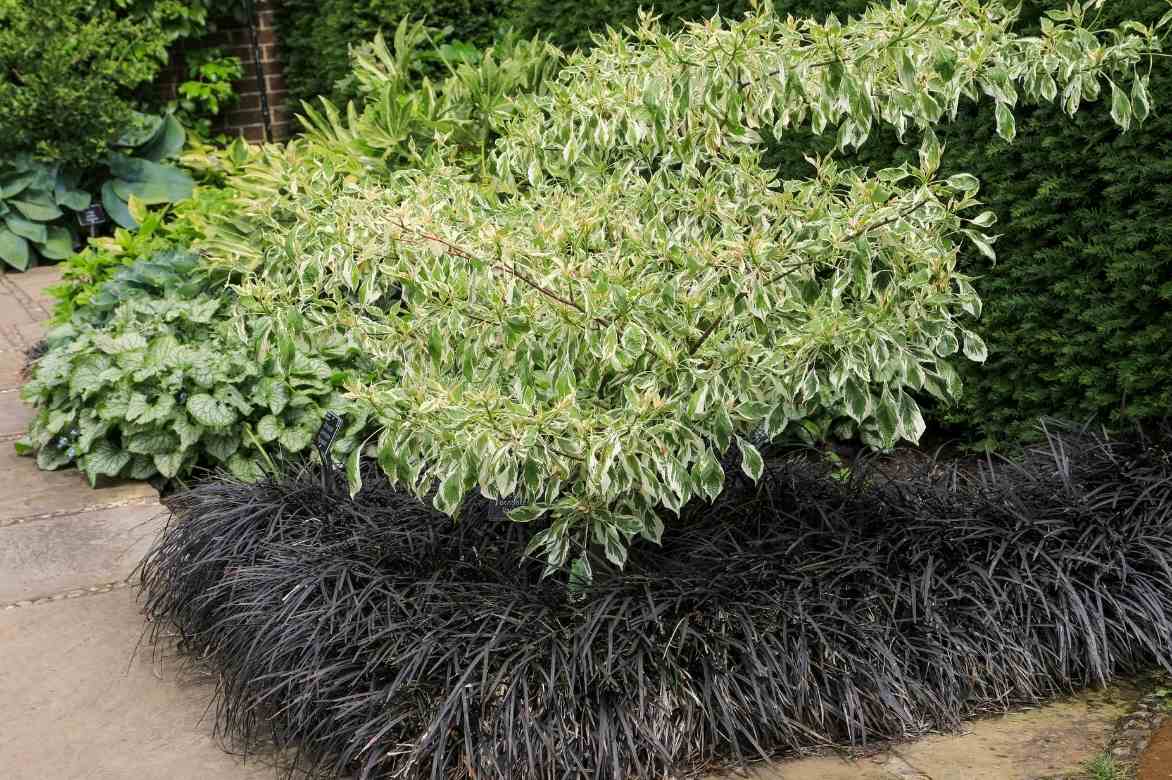
Cornus controversa ‘Variegata’ and Ophiopogon planiscapus ‘Nigrescens’
How to Plant?
- Soak your potted dogwood in a large bucket of water for several dozen minutes to rehydrate the root ball.
- Dig a hole twice the depth of the root ball and twice its width. Keep the excavated soil and loosen it.
- Loosen the soil at the bottom of the hole using a hoe or pickaxe.
- If your soil is not sufficiently well-drained (very compact soil), you can mix gravel into the excavated soil. Avoid Rhine sand, which can sometimes do more harm than good in very clayey soils, and skip placing gravel at the bottom of the hole, as this can create a sort of “sump” filled with water right at the root level, which is also not ideal. Compost will also improve the soil texture.
- Remove your tree from its pot and check the quality of the roots. Cut off any damaged or rotten roots. Don’t hesitate to untangle the root ball and remove most of the potting soil from the root ball, especially for autumn planting.
- Add several handfuls of well-rotted compost to the planting hole.
- Prepare a root slurry (pralin): a few handfuls of soil, a good handful of decomposed manure, and add rainwater until you form a sticky mud. Dip the roots of your tree into this mud. The slurry will provide everything the roots need to kickstart their growth.
- Place your tree at the bottom of the hole, hold it upright, and then backfill the hole with your soil.
- Make sure not to cover the collar of the tree (the part between the roots and the aerial part). Planting on a slight mound is ideal. Keeping the collar above the soil allows the lateral roots to spread and “breathe.” The tree is less prone to disease, better anchored, and grows faster.
- Gently firm the soil around the tree without damaging the roots and create a shallow basin around it to keep water at its base.
- Water with ten litres of water. This step is important to avoid any potential “air pockets” between the roots and the soil.
- A good mulch of dead leaves at the base or, even better, planting ground-cover perennials will help keep the soil moist throughout the year.
Read also
5 ideas for pairing flowering dogwoodCaring for Your Pagoda Dogwood
Watering
The soil should not be dry in summer or waterlogged in winter! Flowering dogwoods are sensitive to water stress. We recommend using mulching to maintain moisture and also to protect the roots from winter harshness.
Water regularly during the first year, one watering can per week. After that, watering is unnecessary except in regions where drought is common.
Pruning
No pruning is necessary. Cleaning is limited to dead branches in March. You can optionally remove branches that cross or seem poorly placed (which is rare in this type of tree or bush). Do not attempt to restrict its growth in width and height, as this will harm its shape. Think carefully about the size your dogwood can reach once mature.
Possible diseases and pests
The Cornus controversa can be affected by anthracnose (or black spot disease), a fungal disease. Anthracnose manifests as brownish spots edged with purple, necrosis on the leaves and twigs. These fungi take advantage of wounds to enter, so do not prune. Simply remove dead wood. Avoid watering the foliage and burn any leaves showing signs of anthracnose, including those that have fallen to the ground.
Powdery mildew (white disease) can also affect dogwoods. A white, powdery coating appears on the leaves, which then deform and dry out. This disease can occur in humid conditions with significant temperature fluctuations between day and night. Ensuring good air circulation between plants helps prevent fungal infections.
Propagating a Cornus controversa
By Sowing
Sowing is unpredictable, as few seeds are fertile, and in any case, sowing will rarely produce the same cultivar as the parent plant: more often than not, the seedlings will revert to the typical Cornus controversa (which is also magnificent!). Harvest the seeds from ripe fruits in October, soak them for 24 hours, and then sow them in pots with a well-draining substrate. Leave the pots in a cold frame and only move them out the following spring. Place your pots in partial shade and keep the substrate moist but not waterlogged. Transplant your young plants individually once they have four leaves, and plant them in the ground the following autumn.
By Grafting
This is the method preferred by professionals. Shield grafting in November yields good results when using a typical Cornus controversa rootstock.
Beware! Some graft Cornus controversa and C. alternifolia onto other dogwoods, which are cheaper to produce and very vigorous (e.g., C. alba, C. sanguinea, C. amomum, etc.). This solution is economical, but… the rootstock often produces suckers from the base, which makes the tree unsightly and obscures its tiered structure. In such cases, these suckers must be pruned relentlessly. Be wary of Cornus controversa and Cornus alternifolia that are too cheap!
→ Learn more about multiplying dogwoods in our tutorial!
How to pair the Pagoda Dogwood?
If you have planted your Cornus controversa ‘Variegata’ as a standalone feature in your garden, for example in the centre of a short grass meadow, let’s keep the accompaniment simple. A few understated perennial ground covers will be perfect at its base: Pachysandras, Brunneras, Ajugas, Geranium macrorrhizum… and why not, if your soil is sufficiently moist, the Cornus canadensis.
But this type of dogwood also stands out in a modern, minimalist garden style alongside a few ornamental grasses, such as Calamagrostis acutiflora ‘Karl Foerster’, Helictotrichon sempervirens, or Carex comans ‘Bronze Form’.
As for the alternate-leaved dogwood, despite its American origins, this small tree pairs well with Asian species in a Japanese-inspired garden style. A Cornus alternifolia ‘Golden Shadow’ will find good company with an Acer palmatum ‘Butterfly’, a Rhododendron ponticum ‘Variegatum’ with variegated leaves and mauve flowers (which will contrast beautifully with the yellow foliage of the dogwood), and a Pieris japonica ‘Forest Flame’. A few ferns will complete the picture.
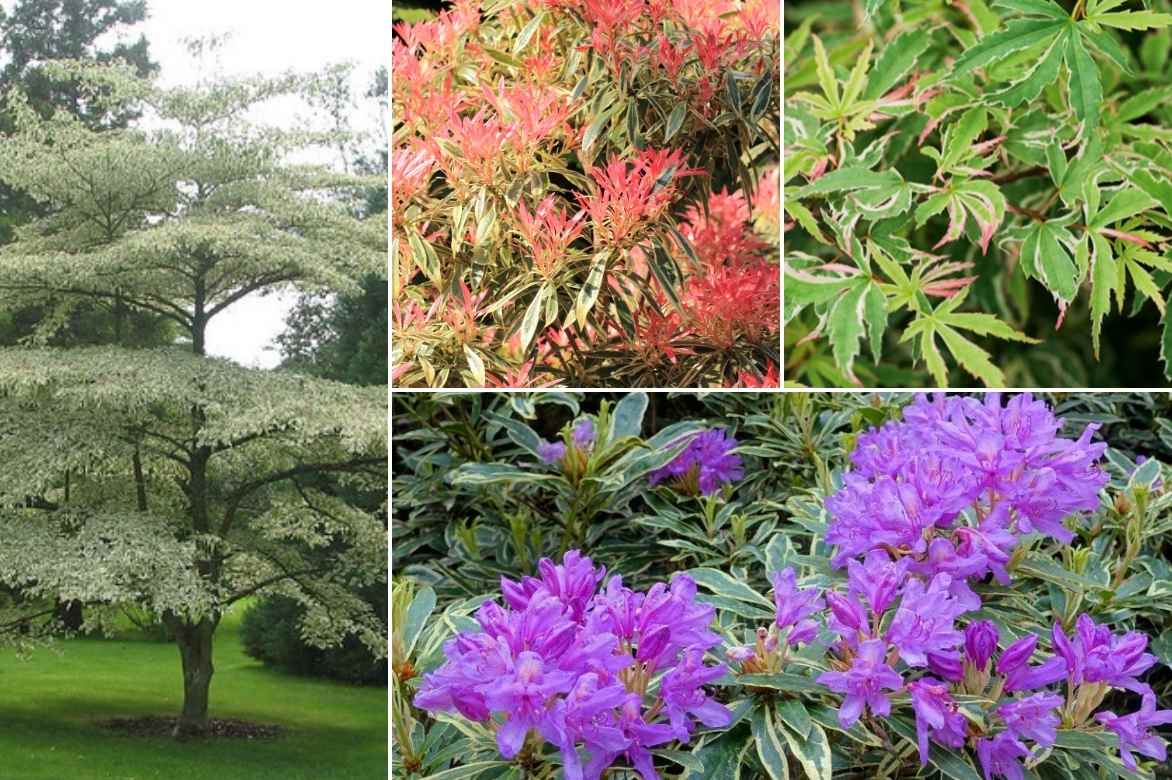
Cornus alternifolia ‘Argentea’, Pieris japonica ‘Forest Flame’, Acer palmatum ‘Butterfly’, and Rhododendron ponticum ‘Variegatum’
Anecdotes and possible remarks
- The Pagoda Dogwood is called “Table Dogwood” in English;
- The species name “controversa” means “controversial” or “divergent” due to its branches that increasingly spread away from the trunk over the years;
- Its hard wood (as with all dogwoods!) is still used today in Japan to make kitchen utensils, small sculptures, or sometimes the soles of traditional shoes.
Also worth reading
- Discover our wide selection of Cornus or dogwoods in our online nursery.
- Flowering dogwoods are stunning in spring—discover them now!
- Looking for winter colour? Choose your coloured-wood dogwoods.
- Check out our advice guide: 10 dogwoods for a small garden.
- Subscribe!
- Contents































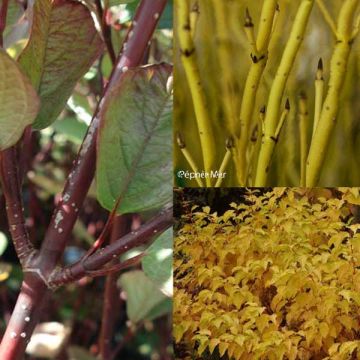


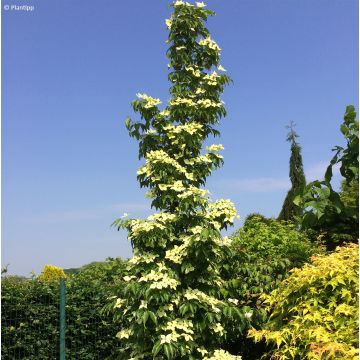


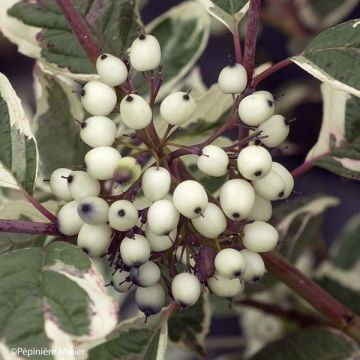

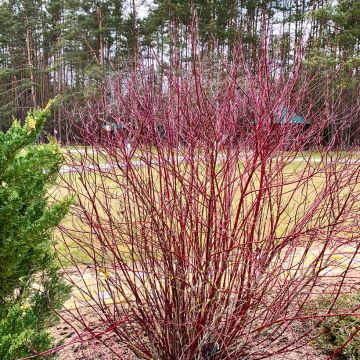
Comments